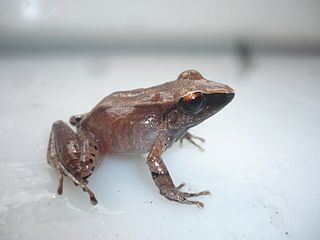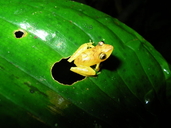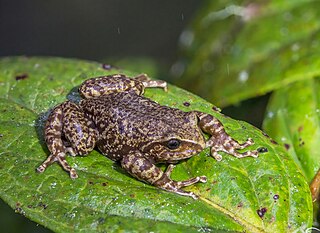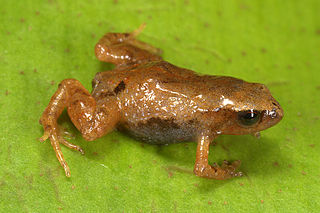
The spider species Araneus diadematus is commonly called the European garden spider, cross orbweaver, diadem spider, orangie, cross spider, and crowned orb weaver. It is sometimes called the pumpkin spider, although this name is also used for a different species, Araneus marmoreus. It is an orb-weaver spider found in Europe, where it is native, and North America, where it was introduced.
Pristimantis appendiculatus, the Pinocchio rainfrog, is a species of frog in the family Strabomantidae. It is found on the Pacific slopes of the Andes in Ecuador and extreme southern Colombia.

Pristimantis buccinator is a species of frog in the family Strabomantidae. It is found in Peru, and possibly Brazil and Bolivia. Its natural habitat is tropical moist lowland forests.
Pristimantis calcarulatus is a species of frog in the family Strabomantidae. It is found in Colombia and Ecuador. Its natural habitats are tropical moist montane forests and rivers. It is threatened by habitat loss.
Pristimantis carvalhoi is a species of frog in the family Strabomantidae. It is found in the upper Amazon Basin in Bolivia, Brazil, Colombia, Ecuador, and Peru. It occurs in primary and secondary flooding forest with close canopy. Though it can locally suffer from habitat loss, it is not threatened overall.

Pristimantis caryophyllaceus is a species of frog in the family Strabomantidae. It is found in Costa Rica and Panama; records from Colombia prior to 2010 refer to Pristimantis educatoris. However, taxonomy of Pristimantis caryophyllaceus and P. educatoris remain unsettled, and many sources continue to report Pristimantis caryophyllaceus from Colombia.
Pristimantis colostichos is a species of frog in the family Strabomantidae. It is endemic to Venezuela. Its natural habitat is tropical high-altitude grassland. It is threatened by habitat loss.
Pristimantis cremnobates is a species of frog in the family Strabomantidae. It is endemic to Ecuador. Its natural habitats are tropical moist montane forests and rivers. It is threatened by habitat loss.

Pristimantis curtipes is a species of frog in the family Strabomantidae. It is found in the Nariño Department of southern Colombia and in the Andes of Ecuador south to Desierto de Palmira.
Pristimantis devillei is a species of frog in the family Strabomantidae. It is endemic to Ecuador. Its natural habitats are tropical moist montane forests, high-altitude shrubland, and tundra. It is threatened by habitat loss.
Pristimantis lacrimosus, commonly known as Jiménez's robber frog or the Lloróna frog, is a species of frog in the family Strabomantidae.

Pristimantis muricatus is a species of frog in the family Strabomantidae. It is endemic to Ecuador. Its natural habitats are tropical moist lowland forests and moist montane forests. It is threatened by habitat loss.
Pristimantis pedimontanus is a species of frogs in the family Strabomantidae.
Pristimantis pleurostriatus is a species of frog in the family Strabomantidae. It is endemic to Venezuela. Its natural habitat is tropical moist montane forests.
Pristimantis rubicundus is a species of frog in the family Strabomantidae. It is endemic to Ecuador. Its natural habitat is tropical moist montane forest. It is threatened by habitat loss.
Pristimantis trepidotus is a species of frog in the family Strabomantidae. It is endemic to Ecuador. Its natural habitats are tropical moist montane forest, high-altitude shrubland, and high-altitude grassland. It is threatened by habitat loss.

Pristimantis is a very large genus of frogs distributed in the southern Caribbean islands and in Central and South America from Honduras to northern Argentina and southern Brazil. With 596 described species, the genus had more species than any other genus of vertebrate animals. Many of these species genus are endemic to the Northwestern Andean montane forests ecoregion in north-western South America.

Sumaco Napo-Galeras National Park is a protected area in Ecuador situated in the Napo Province, Orellana Province and Sucumbíos Province. The highest point of the park is the Sumaco volcano that peaks at 3,732 m; the lowest altitude is 600 m.

The Strabomantidae are a family of frogs native to South America. These frogs lack a free-living larval stage and hatch directly into miniature "froglets". This family includes Pristimantis, the most speciose genus of any vertebrate.

Duida–Marahuaca National Park is a protected area in Amazonas state, Venezuela. It has an area of 210,000 ha, and includes the Duida–Marahuaca Massif.










